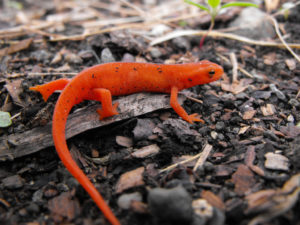In Pennsylvania there are more than 30 species of amphibians. You may find many of these species in your garden, neighborhoods, and parks. Attract amphibians to your property by learning about them and how you can landscape to meet their needs.
Double lives

In Pennsylvania, amphibians consist of what we commonly recognize as frogs, toads, salamanders, and newts. It is the duality of these creatures’ lives that makes them so unique. Amphibian translates to “both lives” or “two lives” in Latin. This refers to the animal’s life spent partially in water and partially on land. Amphibian eggs are laid in water and when they hatch, amphibians resemble fish. They are legless and breath through gills. As they grow, they develop legs and live predominantly on land.
The skin on their backs
Through metamorphosis, adult amphibians develop thin skin that must remain moist. Some amphibians produce a slimy secretion to keep the skin moist. Others must keep their skin wet through contact with water. This thin skin allows oxygen to go directly into an amphibian’s bloodstream. It also enables amphibians to breathe underwater, or use their lungs to breathe on land. Amphibians also absorb water through their skin instead of drinking it through their mouths.
Because of their ability to absorb air and water through their skin, amphibians are sensitive to pollutants. Some pollutants may kill the animal directly, while others cause issues with reproduction or cause birth defects.
6 ways to landscape for amphibians
Provide water
Frogs, toads, and salamanders require standing water in the spring to lay their eggs. Fish eat these eggs, so amphibians prefer water without fish such as marshes, swamps, and “vernal pools”- ponds that exist in the spring, but dry up in the summer. If you have any of these features, embrace them as unique assets to your property. If you don’t have a natural pond, install a water feature to attract amphibians.
Eliminate or minimize pesticide use
Ideally, eliminate all pesticide use. If this is not practicable on your site, look for organic or biological solutions to pest problems. If you do choose a chemical pesticide, always follow label instructions. Read “What to Know Before Reaching for Pesticides” for more information.
Reduce fertilizers
Synthetic fertilizers can be just as damaging to amphibians as some pesticides. Consider whether you really need fertilizer before applying it to lawns, beds, or trees. If you are not sure, test your soil. In most situations, a light application of compost improves the soil and provides adequate nutrients for plants.
Attract amphibians with plants
Similar to reptiles, amphibians do not create their own body heat, so they are sensitive to changes in temperature. Keep water temperatures cool by shading it with trees and shrubs. Additionally, some amphibians, like Spring Peepers climb trees for protection and food. And of course, trees, shrubs, and other plants are critical in keeping water clean and managing localized flooding. Design and plant a rich landscape for amphibians and other creatures.
Stop mowing
If you are fortunate enough to have a body of water on your property, you are certain to attract amphibians. However, amphibians are commonly preyed upon by birds, so provide them with protection by letting plants grow along the water’s edge. This will also improve water quality.
Leave the leaves
Salamanders and other amphibians use fallen leaves as places to hide and overwinter. Manage leaves responsibly to attract amphibians.
Learn more about amphibians and their habitats
The lack of knowledge in regard to these creatures is considered one of the biggest threats to their populations. See the Negative impact of fertilizers and pesticides on amphibians, Oregon State University to start.
Remember, sustainable landscaping is a holistic approach to the landscape. Our actions on land impact more than we might imagine. Manage the land thoughtfully to not only benefit plants and animals, but to also forge a deeper connection to our environment.
If you are interested in studying amphibians up close, consider participating in the Pennsylvania Amphibian and Reptile Survey (PARS). This state-wide survey asks volunteers of all experience levels to collect information and photos of local amphibians and reptiles.

